Home > News > Specials
The Rediff Special/Archana Masih in Car Nicobar
June 24, 2005
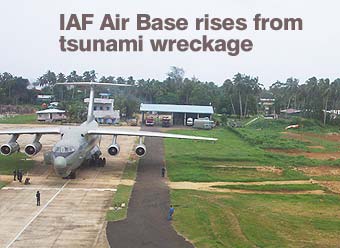
The Indian Air Force's base on the Car Nicobar island was devastated in the tsunami. One hundred and sixteen IAF officers and men, their wives and children died in the disaster. Little remained of the air base, which was established as India's southernmost defence post, a sentinel against the unseen forces lurking in regions nearby. The morning of December 26 changed all that.
In true military spirit, IAF personnel worked night and day to ensure that the air base was operational again, just three-and-a-half months after the ocean claimed 3,513 lives in Andaman and Nicobar.
Senior Features Editor Archana L Masih reports on a day in the life of the Car Nic Air Base. The first of a series on life in the Andaman and Nicobar islands, six months after the tsunami.
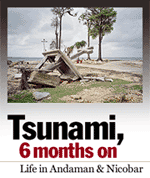
When Wing Commander Nitin Sathe is through for the day in his office, he just walks around his table and arrives home.
His home is in the same room, on the left side of his large desk. Across a white wooden partition that separates his office from his personal space which comprises a neat single bed, a rack of books and a handful of personal belongings.
"People can call me at any hour and I can say -- 'I'm in office'," laughs the officer endowed with tremendous good humour.
WingCo Sathe, as he is referred to by the other officers, is the chief operating officer of the Car Nicobar Air Base. He arrived at the base -- India's southernmost Air Force station in the Bay of Bengal -- on New Year's day, five days after the tsunami devoured the base, reducing it to a wasteland of rubble and corpses.
On April 14, the Car Nic Air Base resumed operations once again. "The runway is repaired, navigational aids and the basic infrastructure is in place. The operational capabilities of the station is back to normal," he says studying his presentation on a laptop, taking us through a series of 'then and now' pictures.
"In fact, we have seen more planes landing and taking off after the tsunami than before."
In a few weeks, he and the other 26 officers stationed there, will move out of their college kind of room sharing arrangements in their office block to a newly constructed living accommodation. Made of special earthquake resistant material, the quarters are very basic -- one room with attached bath, two beds, separated by a table and a cupboard.
There are no frills, no luxuries and there is every possibility that officers will continue to share rooms like they have been doing these past six months. The amenities are very rudimentary but they know they are working in unusual circumstances 1,300 kms from the Indian mainland where the geographical location and the destruction of infrastructure has torn life and affected communication.
Picked up from different air bases in India, they were sent to Car Nic immediately after the tsunami to rebuild the air base from the dust.
"When we arrived here, all the surviving previous staff was being evacuated. They were all so distraught that we hardly had any time for the formal handing over of charge by them. We just had to pick up from scratch. We did not even know stuff like where the keys to the cupboards etc were," says Squadron Leader P M Beniwal, who had been transferred from the base in July 2004 and was reassigned to CarNic after the tsunami.
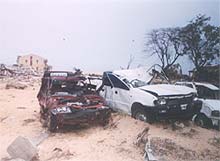
For a first time visitor to the base, the sight can be shocking. The destruction is so overwhelming that just imagining what it must have looked like when the waters raged in on December 26 leave you numb.
In fact, the scale of the devastation on Car Nicobar island becomes most evident only on entering the Air Base because en route all villages have been flattened reducing them to an empty ghost land with sinister boards reading 'Erstwhile Perka, Erstwhile Small Lalpathy, Erstwhile Malacca.' The Erstwhile indicating where the villages and their inhabitants once stood and lived.
"The homes in these villages did not have much concrete and were made of wood, so they were completely washed away. That is why only few pillars can be seen in the debris, the rest has been flattened," says Squadron Leader Beniwal as we drive down the road on the eastern side of the island.
The Air Base, on the other end of the island, was a full-fledged helicopter station with a huge infrastructure. Around 700 staff and personnel lived there with their families. It had two schools, VIP guest houses for the air chief marshal and other visiting dignitaries, a shopping complex and homes for the station commander, officers and air men.
The concrete rubble, the partially destroyed structures and the 160 acres of land lost to water ingress here have to be seen to understand the quantum of destruction.
Today, after six months of clearing the debris, what remains is a chilling reminder of the tragedy. Cars lie in mangled heaps, homes seem to have been blasted into unrecognisable shapes -- second floors flung upside down, blackened trees lying in gigantic tangled piles. A refrigerator flung out of someone's kitchen is now lodged in the branches of a tree.
"There is a 500 per cent improvement in the quality of life now," says the chief operating officer, "At that time we were cutting plastic bottles into two to use them as plates and did not have spare laces for our shoes when they broke."
The first priority was to get the runway working for relief activity and the men made use of whatever came their way -- even axes to chop the wood and manually pushed it off the runway.
The 9,000 feet runway, originally measured around 3,000 feet when it was constructed by the Japanese during their occupation of the island between 1942 and 1945 in the Second World War. It was taken over by the Indian Air Force in 1956.
Forty-five tons of epoxy was used to repair the runway. The repairs began every day, post 4 pm, after the flights for the day ended. The work went on through the night till 4 am. The epoxy needed three hours to dry and the flights resumed at around 7 am.
The highest point at the air base is on the runway -- it is called Middle Point. "We have instructions that in the event of an earthquake we should run towards Middle Point," says Sqd Ldr Beniwal standing near the erstwhile home of his friend Squadron Leader Rajshekhar who perished along with his wife and son in the tsunami.
Their daughter Meghna miraculously survived the disaster by floating on a door. She now lives with her grandmother in Hyderabad. "I used to live across the street and used to play with Sqd Ldr Rajshekhar's children. Meghna's grandmother sent me a picture of her recently," says Sqd Ldr Beniwal.
A few minutes later as we pass through the cluster of the wreckage of cars, Sqd Ldr Beniwal points to the remains of a gray Daewoo [Get Quote] Matisse. "That used to be Sqd Ldr Rajshekhar's car," he says.
***
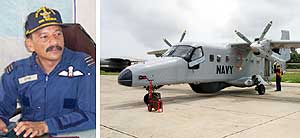 The Air Base lost 116 officers, men and family to the tsunami. Those who survived were immediately evacuated, given a month's leave and subsequently transferred to other stations. The base was no longer deemed a family station and new officers and men were sent to replace, rebuild and carry out the relief operation -- Operation Madad (Help).
The Air Base lost 116 officers, men and family to the tsunami. Those who survived were immediately evacuated, given a month's leave and subsequently transferred to other stations. The base was no longer deemed a family station and new officers and men were sent to replace, rebuild and carry out the relief operation -- Operation Madad (Help).
WingCo Sathe (right), who has maintained a journal of those days, remembers taking a broom and sweeping a path in a room full of glass. Since there was no water in those early days, two officers shared a 25 litre can of mineral water for bathing and ablutions.
The officers and men got down to clearing the debris, disposing the bodies and spent all their waking hours bringing some semblance of order. Rice, dal and vegetables was eaten by the officers and men from a common kitchen. Pilots who flew down as part of the relief activity sometimes stayed on to work for a month or so and would feel sad about leaving. The first break from work came on January 16 when everyone went for a picnic.
At the peak of the relief effort, around 5,000 men were pressed into service. Around 10,000 residents were evacuated in Op Madad from the Car Nicobar island. The IAF flew around 226 sorties till January 26.
"Today there are 400 to 500 men involved on an as required basis," says Lieutenant General Aditya Singh, commander-in-chief, Andaman and Nicobar Command.
Offices have been repaired and airmen quarters restored. The officers dine at the temporary mess because the grand officers mess was destroyed, and spend most of their time at work. "Our families are not here so there is no distraction," says Sqd Leader Beniwal.
Their day begins at 5 am and work at 7 am. Lunch is around 2 pm and work officially gets over around 6 pm but there is always something to do in their 'home office'. Phone calls from HQ, visiting VIPs, liaisoning with the civil administration.
Television viewing is restricted to Doordarshan because the cable television connection is yet to be restored. At times the signal is weak and cell phones do not work, but landlines at the base are operational. Newspapers are flown in, depending on the weather. A television channel crew had to spend an extra three days on Car Nic this week because no flight could operate in the downpour. For entertainment, the staff sometimes watch a DVD/VCD, go for walks in the morning and evening and play volleyball or basketball.
Officers will serve at the base for a year-and-a-half, the tenure for a 'hard area' posting; a regular posting lasts two to three years. The ministry of defence is looking for 170 acres away from the sea to build new housing blocks, and it is estimated it will take two years to complete the rebuilding process at the base.
"We are living normal lives now. We have come a long way from what we were to what we are today," feel the officers.
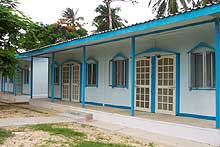
On the tarmac, visible from his office, are a Dornier 228 and one IL-76 -- a huge heavy lift aircraft used to transport landmovers etc to the base. It can accommodate a helicopter in its belly. Both aircraft are ready for take off.
Tomorrow is a busy day when a delegation of MPs including the Leader of the Opposition L K Advani arrive at the base. A television crew is expected before that and a group of teachers are to arrive the following week. A chopper is to be loaded in the IL and a long queue of people walk into the aircraft.
It is after 1 in the afternoon and Wing Commander Sathe, Squadron Leader Beniwal and Wing Commander N K Atri are at the runway in the air base they and their amazing team had come to rebuild. It is the middle of their usual day.
Photographs: Archana Masih and A Ganesh Nadar. Image and logo: Dominic Xavier